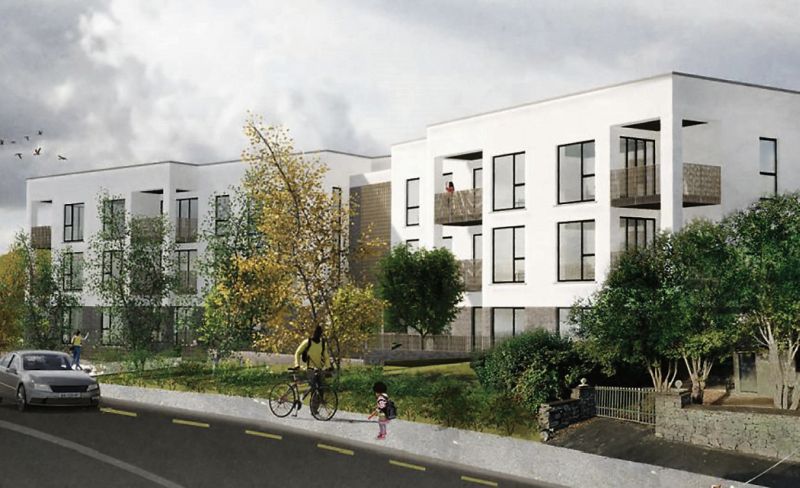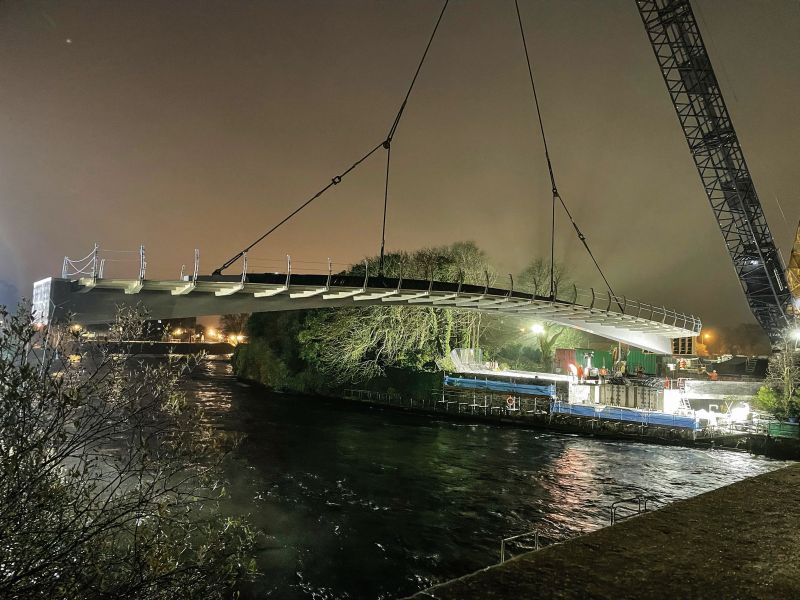CITY TRIBUNE
Lack of transport options sinks Galway City social housing and Traveller homes plan

From the Galway City Tribune – An Bord Pleanála has rejected plans for a social housing scheme in Castlegar – citing the lack of pedestrian, cycle and bus connections at the site.
Last July, Galway City Council applied directly to the higher planning authority for permission to build three Traveller-appropriate houses and 21 apartments on the Headford Road in a mixture of two and three-storey buildings on what is currently a 2.2-acre field immediately north of U-hire van hire business.
The three-storey apartment block plan included 3 one-bed, 14 two-bed and 4 three-bed units, and there were 3 four-bed ‘Traveller Appropriate Accommodation’ units in the proposals.
There was also parking for 39 cars and 10 sheltered bike spaces proposed for the courtyard of the apartment building.
“The design of the own-door access to ground floor units with large protected terraces will also accommodate safe storage of bicycles,” the application reads.
It also noted that the site is an eight-minute walk from the 407 bus stop at Bóthar an Choiste and “is remote from neighbourhood/community services”.
“The proposal includes a range of informal spaces to cater for all age groups including seating areas, walking loops, a play area, and a large kick-about area. The landscaping and public open space will contribute to creating a safe, secure and enjoyable environment for all users. The landscape proposal has been reviewed with Galway City Council Parks Department, and GCC criteria for the design of open space and specification preferences and maintenance requirements have been incorporated into the proposal.
“The Traveller appropriate accommodation element of the project has been informed by consultation between GCC Housing Department and Traveller representatives.
“The key concerns of the Traveller representatives identified through this consultation process were in relation to achieving a sense of community and a sense of security/privacy. The location of the houses on the site responds to these concerns.
“The three houses are located together in a row to the south-west of the site, facing the main entrance. The houses are clearly distinct from the social housing apartment building, while also a part of the overall development. The aim of this is to retain a sense of community among the group and reduce the potential impact of relocating to an unfamiliar location, such as isolation or loss of identity.
“The houses are detached, and back gardens are facing onto the excavated soil and rock face to the west of the site. This is the preference of the group as alleviates the concerns in relation to security, privacy and overlooking which would occur in a back-to-back arrangement.
“A concrete retaining wall is required for the excavations, and this is tall enough to prevent climbing to the upper part of the slope. A hard-standing area within the curtilage of each house will facilitate a car, van and horse-box for each house,” the application reads.
A Natura Impact Statement included with the plans found there were potentially significant effects identified for the Lough Corrib and Galway Bay Complex SACs (Special Areas of Conservation) and the Lough Corrib and Inner Galway Bay SPAs (Special Protection Areas), there were a range of mitigation and avoidance measures suggested to offset them.
“It has been concluded that . . . the proposed development will have no adverse effects on the [on those areas],” the report found.
There were five submissions on the application, with issues raised relating to the site being “at a remove” from local amenities, therefore there reduced active travel options for residents.
Issues were also highlighted around the lack of cycling and pedestrian infrastructure on that section of the Headford Road and there being high incidents of collisions.
High traffic volumes, lack of public transport, lack of footpaths, noise pollution, road safety, crime and anti-social behaviour were also highlighted in submissions to An Bord Pleanála.
The Board ruled: “Notwithstanding the residential zoning objective for the site, it is considered that the proposed development due its peripheral location and the lack of adequate and safe pedestrian and cycle linkages and adequate bus connections with the built up area of the city and associated facilities and services, the proposed development would be excessively car dependent and with a lack of alternative travel options would, be contrary to national, regional and local policy objectives relating to compact growth and sustainable mobility.”
This article first appeared in the print edition of the Galway City Tribune, November 4. You can support our journalism by subscribing to the Galway City Tribune HERE. The print edition is in shops every Friday.
CITY TRIBUNE
Galway ‘masterplan’ needed to tackle housing and transport crises

From the Galway City Tribune – An impassioned plea for a ‘masterplan’ that would guide Galway City into the future has been made in the Dáil. Galway West TD Catherine Connolly stated this week that there needed to be an all-inclusive approach with “vision and leadership” in order to build a sustainable city.
Deputy Connolly spoke at length at the crisis surrounding traffic and housing in Galway city and said that not all of the blame could be laid at the door of the local authority.
She said that her preference would be the provision of light rail as the main form of public transport, but that this would have to be driven by the government.
“I sat on the local council for 17 years and despaired at all of the solutions going down one road, metaphorically and literally. In 2005 we put Park & Ride into the development plan, but that has not been rolled out. A 2016 transport strategy was outdated at the time and still has not been updated.
“Due to the housing crisis in the city, a task force was set up in 2019. Not a single report or analysis has been published on the cause of the crisis,” added Deputy Connolly.
She then referred to a report from the Land Development Agency (LDA) that identified lands suitable for the provision of housing. But she said that two-thirds of these had significant problems and a large portion was in Merlin Park University Hospital which, she said, would never have housing built on it.
In response, Minister Simon Harris spoke of the continuing job investment in the city and also in higher education, which is his portfolio.
But turning his attention to traffic congestion, he accepted that there were “real issues” when it came to transport, mobility and accessibility around Galway.
“We share the view that we need a Park & Ride facility and I understand there are also Bus Connects plans.
“I also suggest that the City Council reflect on her comments. I am proud to be in a Government that is providing unparalleled levels of investment to local authorities and unparalleled opportunities for local authorities to draw down,” he said.
Then Minister Harris referred to the controversial Galway City Outer Ring Road which he said was “struck down by An Bord Pleanála”, despite a lot of energy having been put into that project.
However, Deputy Connolly picked up on this and pointed out that An Bord Pleanála did not say ‘No’ to the ring road.
“The High Court said ‘No’ to the ring road because An Bord Pleanála acknowledged it failed utterly to consider climate change and our climate change obligations.
“That tells us something about An Bord Pleanála and the management that submitted such a plan.”
In the end, Minister Harris agreed that there needed to be a masterplan for Galway City.
“I suggest it is for the local authority to come up with a vision and then work with the Government to try to fund and implement that.”
CITY TRIBUNE
Official opening of Galway’s new pedestrian and cycle bridge

The new Salmon Weir pedestrian and cycle bridge will be officially opened to the public next Friday, May 26.
Work on the €10 million bridge got underway in April 2022, before the main structure was hoisted into place in early December.
A lunchtime tape-cutting ceremony will take place on Friday, as the first pedestrians and cyclists traverse the as-yet-unnamed bridge.
The Chief Executive of Galway City Council, Brendan McGrath, previously said the bridge, once opened, would remove existing conflicts between pedestrians, cyclists and traffic “as well as facilitating the Cross-City Link public transport corridor over the existing 200-year-old bridge”.
The naming of the new bridge has been under discussion by the Council’s Civic Commemorations Committee since late last year.
One name that has been in the mix for some time is that of the first woman in Europe to graduate with an engineering degree – Alice Perry.
Ms Perry, who was from Wellpark, graduated from Queen’s College Galway (now University of Galway) in 1906. The university’s engineering building is named in her honour.
The bridge was built by Jons Civil Engineering firm in County Meath and was assembled off-site before being transported to Galway. Funding for the project was provided in full by the National Transport Authority and the European Regional Development Fund.
(Photo: Sheila Gallagher captured the city’s new pedestrian footbridge being raised on the south side of the Salmon Weir Bridge in December. It will officially open next Friday, May 26).
CITY TRIBUNE
Minister branded ‘a disgrace’ for reversing land rezoning in Galway City

From the Galway City Tribune – Minister of State for Local Government and Planning, Kieran O’Donnell was labelled a “disgrace” for overturning councillors’ decisions to rezone land in the new City Development Plan.
Minister O’Donnell (pictured) confirmed in a letter to Council Chief Executive Brendan McGrath last week that he was reversing 25 material alternations made by councillors to the CDP 2023-29. He made the decision on the advice of Office of Planning Regulator (OPR).
Minister O’Donnell directed that 14 land parcels that were subject to land-use zoning changes by councillors as part of the Material Alterations to the Draft CDP should be reversed.
He directed that a further 11 land parcels in the city should become “unzoned”.
The Minister found that the CDP had not been made in a manner consistent with recommendations of the OPR, which required specific changes to the plan to ensure consistency with the national planning laws and guidelines.
At last week’s Council meeting Cllr Eddie Hoare (FG) asked for clarity on the process by which councillors could rezone the lands that had been changed by the Minister’s direction.
Cllr Declan McDonnell said, “What he [Minister O’Donnell] has done is an absolute disgrace”.
And he asked: “Do we have to have another development plan meeting to deal with it?”
Both Cllrs Hoare and McDonnell wondered what would become of the lands that were rezoned or unzoned by the ministerial direction.
Mr McGrath said the Council had put forward an argument in favour of retaining the material alterations in the plan, but ultimately the Minister sided with OPR.
He said if councillors want to make alterations to the new plan, they could go through the process of making a material alteration but this was lengthy.
The Save Roscam Peninsula campaign welcomed the Minister’s decision.
In a statement to the Galway City Tribune, it said the direction would mean the Roscam village area on the Roscam Peninsula will be unzoned and a number of land parcels would revert back to agriculture/high amenity.
A spokesperson for the campaign said: “the material alterations made by city councillors following lobbying by developers continued the long-standing practice of councillors facilitating a developer-led plan rather than an evidence- and policy-based plan that meets the needs of the city.
“The Minister’s direction is an important step in restoring confidence in the planning system. It is clear from the City Council’s own evidence on future housing projections that there was no requirement to zone these lands for residential purposes in order to meet the needs of the targeted population increase up to 2029,” the spokesperson added.









